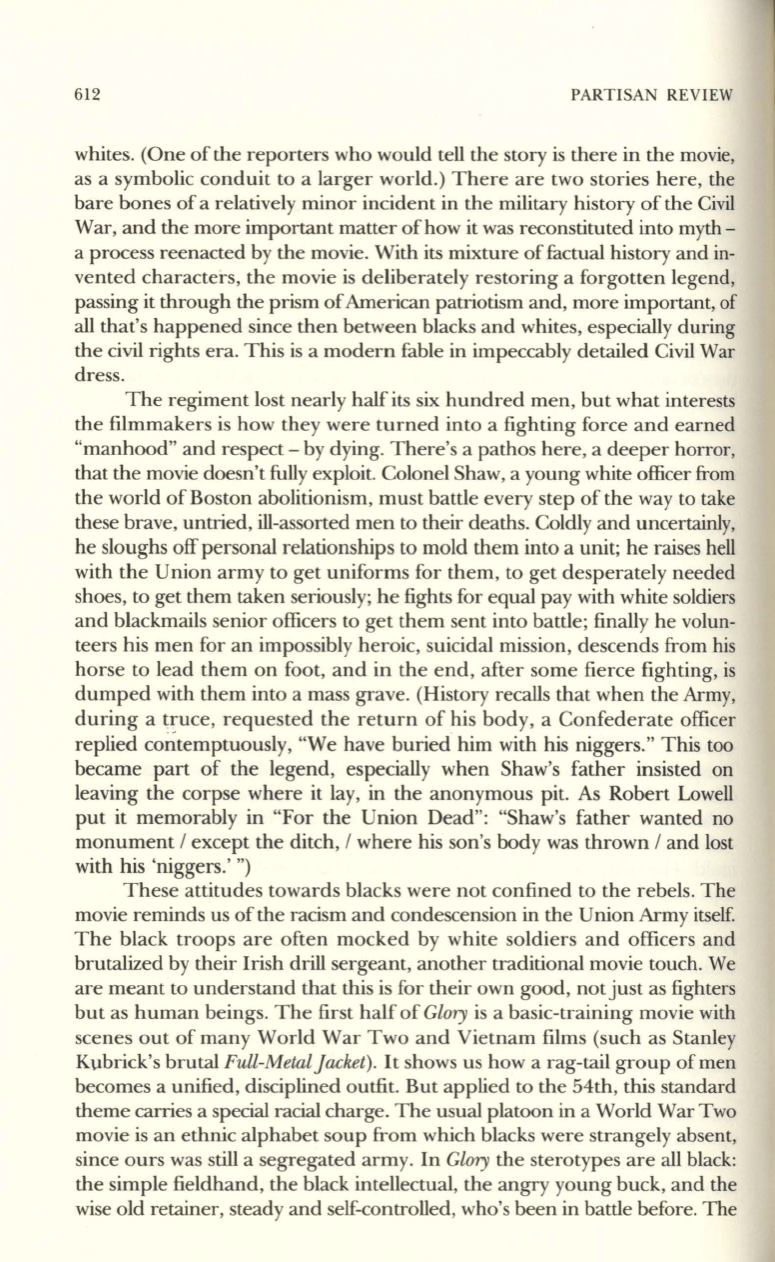
612
PARTISAN REVIEW
whites. (One of the reporters who would tell the story is there in the movie,
as a symbolic conduit to a larger world.) There are two stories here, the
bare bones of a relatively minor incident in the military history of the Civil
War, and the more important matter of how it was reconstituted into myth–
a process reenacted by the movie. With its mixture of factual history and in–
vented characters, the movie is deliberately restoring a forgotten legend,
passing it through the prism ofAmerican patriotism and, more important, of
all that's happened since then between blacks and whites, especially during
the civil rights era. This is a modern fable in impeccably detailed Civil War
dress.
The regiment lost nearly half its six hundred men, but what interests
the filmmakers is how they were turned into a fighting force and earned
"manhood" and respect - by dying. There's a pathos here, a deeper horror,
that the movie doesn't fully exploit. Colonel Shaw, a young white officer from
the world of Boston abolitionism, must battle every step of the way to take
these brave, untried, ill-assorted men to their deaths. Coldly and uncertainly,
he sloughs off personal relationships
to
mold them into a unit; he raises hell
with the Union army to get uniforms for them, to get desperately needed
shoes, to get them taken seriously; he fights for equal pay with white soldiers
and blackmails senior officers to get them sent into battle; finally he volun–
teers his men for an impossibly heroic, suicidal mission, descends from his
horse to lead them on foot , and in the end , after some fierce fighting, is
dumped with them into a mass grave. (History recalls that when the Army,
during a truce, requested the return of his body, a Confederate officer
replied coi-itemptuously, "We have buried"him with his niggers. " This too
became part of the legend, especially when Shaw's father insisted on
leaving the corpse where it lay, in the anonymous pit. As Robert Lowell
put it memorably in "For the Union Dead": "Shaw's father wanted no
monument / except the ditch, / where his son's body was thrown / and lost
with his 'niggers.' ")
These attitudes towards blacks were not confined to the rebels. The
movie reminds us of the racism and condescension in the Union Army itself.
The black troops are often mocked by white soldiers and officers and
brutalized by their Irish drill sergeant, another traditional movie touch. We
are meant to understand that this is for their own good, not just as fighters
but as human beings. The first half of
Glory
is a basic-training movie with
scenes out of many World War Two and Vietnam films (such as Stanley
Kubrick's brutal
Full-Metal jacket) .
It
shows us how a rag-tail group of men
becomes a unified, disciplined outfit. But applied to the 54th, this standard
theme carries a special racial charge. The usual platoon in a World War Two
movie is an ethnic alphabet soup from which blacks were strangely absent,
since ours was still a segregated army. In
Glory
the sterotypes are all black:
the simple fieldhand , the black intellectual, the angry young buck, and the
wise old retainer, steady and self-controlled, who's been in battle before. The


